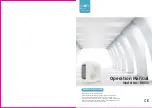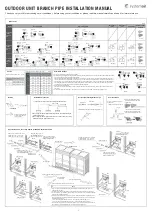
4
ELECTRICAL WIRING
WARNING:
ELECTRICAL SHOCK OR FIRE HAZARD
To avoid risk of electrical shock, personal injury,
or death, disconnect all electrical power to the unit
before performing any maintenance or service. The
unit may have more than one electrical supply.
Label all wires prior to disconnection when
servicing the unit. Wiring errors can cause improper
and dangerous operation.
• All electrical connections must be in compliance with
all applicable local codes and ordinances, and with
the current revision of the National Electric Code
(ANSI/NFPA 70).
• For Canadian installations the electrical connections and
grounding shall comply with the current Canadian Electrical
Code (CSA C22.1 and/or local codes).
Pre-Electrical Checklist
√
Verify that the voltage, frequency, and phase of the supply
source match the specifications on the unit rating plate.
√
Verify that the service provided by the utility is sufficient
to handle the additional load imposed by this equipment.
Refer to the unit wiring label for proper voltage wiring.
√
If replacing an existing unit, verify that the: current wiring,
unit disconnect and circuit breaker is properly sized and
rated for the new units requirements. Verify that information
with the MCA and MOP values on the unit nameplate.
√
Verify factory wiring is in accordance with the unit wiring
diagram. See
Figure 4, (page 6)
, &
Figure 5, (page 6)
.
Inspect for loose connections.
Line Voltage
• A wiring diagram is located on the inside cover of the
electrical box of the outdoor unit. The installer should
become familiar with the wiring diagram before making
any electrical connections to the outdoor unit.
•
An electrical disconnect must be located within sight
of and readily accessible to the unit
. This switch shall
be capable of electrically de-energizing the outdoor unit.
• Line voltage to the unit should be supplied from a dedicated
branch circuit containing the correct fuse or circuit breaker
for the unit. Incoming field wiring and minimum size of
electrical conductors and circuit protection must be in
compliance with information listed on the outdoor unit
data label. Any other wiring methods must be acceptable
to authority having jurisdiction.
• The outdoor unit requires both power and control circuit
electrical connections. Refer to the wiring diagram /
schematic for identification and location of outdoor unit
field wiring interfaces. See
Figure 4, (page 6)
, &
Figure 5,
(page 6)
. Make all electrical connections in accordance
with all applicable codes and ordinances.
• Overcurrent protection must be provided at the branch
circuit distribution panel and sized as shown on the unit
rating label and according to applicable local codes. See
the unit rating plate for minimum circuit ampacity (MCA)
CAUTION:
When performing brazing operations always
protect the system components and seals from
the possibility of heat damage. Remove all
caps, plugs and Schrader valve cores on piping
system components just prior to assembly and
brazing. Use good brazing practices to protect
components from the heat and flame of the
brazing torch.
After outdoor and indoor unit placement has been determined,
route refrigerant tubing between the equipment in accordance
with sound installation practices.
• Refrigerant tubing should be routed in a manner that
minimizes the length of tubing and the number of bends
in the tubing. If precise forming of refrigerant lines is
required, a copper tubing bender is recommended. Avoid
sharp bends and contact of the refrigerant lines with metal
surfaces.
• Refrigerant tubing should be supported in a manner that the
tubing will not vibrate or abrade during system operation.
• Tubing should be kept clean of foreign debris during
installation.
• Every effort should be made by the installer to ensure that
the field installed refrigerant containing components of
the system have been installed in accordance with these
instructions and sound installation practices to insure
reliable system operation and longevity.
• The maximum recommended interconnecting refrigerant
line lengths is 75 ft. and the vertical elevation difference
between the indoor and outdoor sections should not exceed
20 ft.
• A filter dryer is provided with the unit and must be installed
in the liquid line of the system. If the installation replaces a
system with a filter dryer already present in the liquid line,
the filter dryer must be replaced with the one supplied with
the unit. The filter dryer must be installed in strict accordance
with the manufacturer’s installation instructions.
• Optional equipment such as liquid line solenoid valves,
low ambient, etc., should be installed in strict accordance
with the manufacturer’s installation instructions.
• After the completion of all brazing operations and when
the components have been properly cooled, replace
all the seals, Shrader cores and caps which had been
previously removed. It is recommended that all seals
be either lubricated with a light coat of refrigerant oil.
Always verify that oil applied matches the oil type listed
on the compressor nameplate. A thread sealant which
is compatible with the system refrigerant and oil can be
sparingly applied if desired.
CAUTION:
If repairs are necessary to the refrigerant line-
set or indoor setup after the initial installation,
then when servicing, cover or seal openings to
minimize the exposure of the refrigerant system
to air to prevent accumulation of moisture and
other contaminants.






























